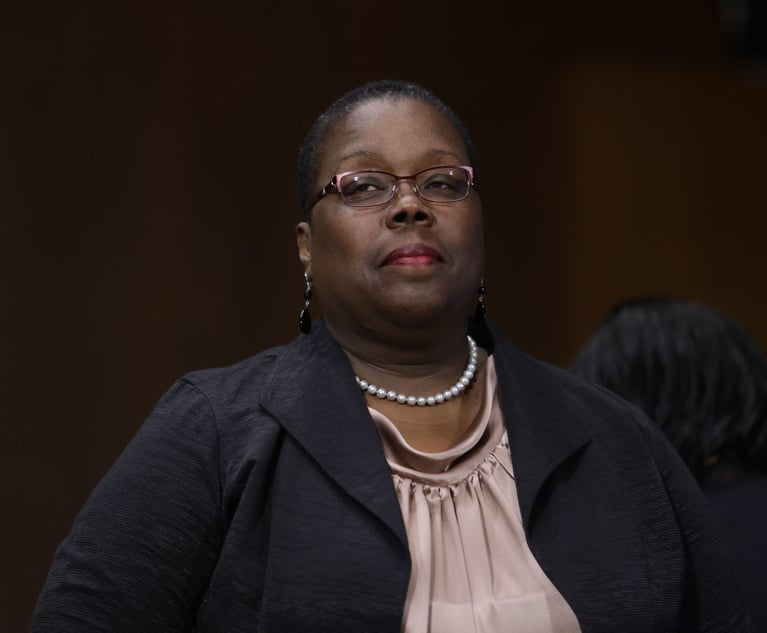'There Is This Battle Over the Language' in Abortion Clashes
Appearing on PBS NewsHour, NLJ's Marcia Coyle spoke about what the court did and did not do—and how the court arrived at its decision.
May 29, 2019 at 04:13 PM
3 minute read
Marcia Coyle, The National Law Journal's senior Washington correspondent, spoke with PBS NewsHour host Lisa Desjardins on Tuesday about the U.S. Supreme Court's split ruling in an Indiana abortion case. The court punted on reviewing whether the state lawfully can restrict certain pre-viability abortions, but the justices upheld the state law requiring abortion providers to bury or cremate fetal remains.
Justices Clarence Thomas and Ruth Bader Ginsburg clashed in the court's decision. Thomas, writing in a 20-page concurring opinion, said Indiana's pre-viability abortion restrictions “promote a state's compelling interest in preventing abortion from becoming a tool of modern-day eugenics.” Ginsburg wrote: “This case implicates 'the right of a woman to choose to have an abortion before viability and to obtain it without undue interference from the state.'”
In her PBS NewsHour appearance, Coyle spoke about what the court did and did not do—and how the court arrived at its decision.
“[Thomas] used his concurrence to trace—basically, he tied together birth control, abortion, and eugenics, and he said that abortion in particular was rife, his words, with the potential for eugenic manipulation,” Coyle said.
Coyle continued: “He used the term 'supposed constitutional right to abortion' in part of his opinion. Justice Ginsburg, she would have turned away Indiana's appeal in its entirety, and she used constitutionally protected right of a woman to have an abortion.
“And she also called out Justice Thomas in a footnote. He had spoken about the mother's right to terminate her pregnancy. Justice Ginsburg said, a woman who terminates—who exercises her constitutionally protected right to terminate her pregnancy is not a mother. So there is this battle over the language, and it does reflect how they view the constitutional right.”
Watch the PBS NewsHour video above or read the full transcript here.
This content has been archived. It is available through our partners, LexisNexis® and Bloomberg Law.
To view this content, please continue to their sites.
Not a Lexis Subscriber?
Subscribe Now
Not a Bloomberg Law Subscriber?
Subscribe Now
NOT FOR REPRINT
© 2024 ALM Global, LLC, All Rights Reserved. Request academic re-use from www.copyright.com. All other uses, submit a request to [email protected]. For more information visit Asset & Logo Licensing.
You Might Like
View All

'A Horrible Reputation for Bad Verdicts': Plaintiffs Attorney Breaks Down $129M Wrongful-Death Verdict From Conservative Venue

Meet the Pacific Northwest Judges Who Rejected the Kroger-Albertsons Supermarket Merger
4 minute read
Trending Stories
Who Got The Work
Michael G. Bongiorno, Andrew Scott Dulberg and Elizabeth E. Driscoll from Wilmer Cutler Pickering Hale and Dorr have stepped in to represent Symbotic Inc., an A.I.-enabled technology platform that focuses on increasing supply chain efficiency, and other defendants in a pending shareholder derivative lawsuit. The case, filed Oct. 2 in Massachusetts District Court by the Brown Law Firm on behalf of Stephen Austen, accuses certain officers and directors of misleading investors in regard to Symbotic's potential for margin growth by failing to disclose that the company was not equipped to timely deploy its systems or manage expenses through project delays. The case, assigned to U.S. District Judge Nathaniel M. Gorton, is 1:24-cv-12522, Austen v. Cohen et al.
Who Got The Work
Edmund Polubinski and Marie Killmond of Davis Polk & Wardwell have entered appearances for data platform software development company MongoDB and other defendants in a pending shareholder derivative lawsuit. The action, filed Oct. 7 in New York Southern District Court by the Brown Law Firm, accuses the company's directors and/or officers of falsely expressing confidence in the company’s restructuring of its sales incentive plan and downplaying the severity of decreases in its upfront commitments. The case is 1:24-cv-07594, Roy v. Ittycheria et al.
Who Got The Work
Amy O. Bruchs and Kurt F. Ellison of Michael Best & Friedrich have entered appearances for Epic Systems Corp. in a pending employment discrimination lawsuit. The suit was filed Sept. 7 in Wisconsin Western District Court by Levine Eisberner LLC and Siri & Glimstad on behalf of a project manager who claims that he was wrongfully terminated after applying for a religious exemption to the defendant's COVID-19 vaccine mandate. The case, assigned to U.S. Magistrate Judge Anita Marie Boor, is 3:24-cv-00630, Secker, Nathan v. Epic Systems Corporation.
Who Got The Work
David X. Sullivan, Thomas J. Finn and Gregory A. Hall from McCarter & English have entered appearances for Sunrun Installation Services in a pending civil rights lawsuit. The complaint was filed Sept. 4 in Connecticut District Court by attorney Robert M. Berke on behalf of former employee George Edward Steins, who was arrested and charged with employing an unregistered home improvement salesperson. The complaint alleges that had Sunrun informed the Connecticut Department of Consumer Protection that the plaintiff's employment had ended in 2017 and that he no longer held Sunrun's home improvement contractor license, he would not have been hit with charges, which were dismissed in May 2024. The case, assigned to U.S. District Judge Jeffrey A. Meyer, is 3:24-cv-01423, Steins v. Sunrun, Inc. et al.
Who Got The Work
Greenberg Traurig shareholder Joshua L. Raskin has entered an appearance for boohoo.com UK Ltd. in a pending patent infringement lawsuit. The suit, filed Sept. 3 in Texas Eastern District Court by Rozier Hardt McDonough on behalf of Alto Dynamics, asserts five patents related to an online shopping platform. The case, assigned to U.S. District Judge Rodney Gilstrap, is 2:24-cv-00719, Alto Dynamics, LLC v. boohoo.com UK Limited.
Featured Firms
Law Offices of Gary Martin Hays & Associates, P.C.
(470) 294-1674
Law Offices of Mark E. Salomone
(857) 444-6468
Smith & Hassler
(713) 739-1250










